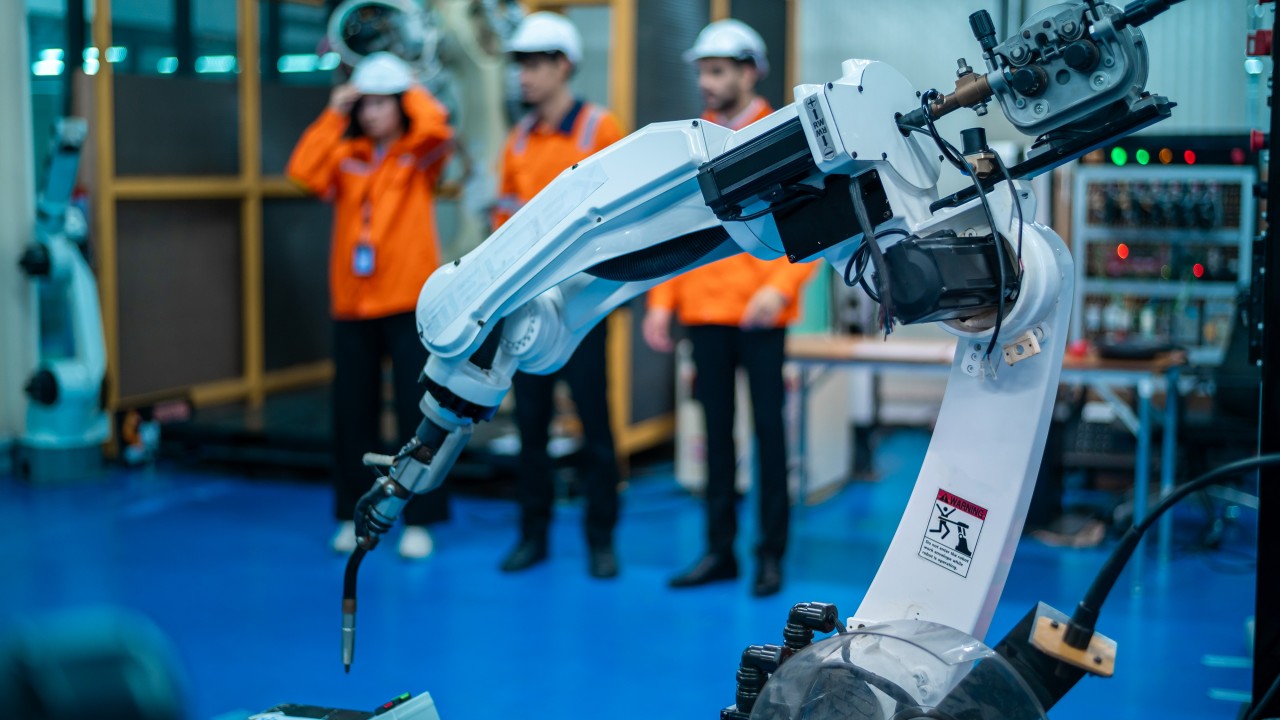
Embracing Digital Transformation with AI: Brainstorming A Few Use Cases
Digital transformation powered by AI opens a wide range of opportunities to enhance customer engagement, streamline operations, and improve decision-making. Below are several practical AI use cases, which our studio can help you implement.

AI Chatbots and Digital Avatars
Businesses are increasingly using AI chatbots and digital avatars to engage with customers 24/7. These intelligent systems can answer customer questions, assist with inquiries, and even provide troubleshooting steps. AI-powered chatbots not only improve response time but also learn from interactions to better understand customer preferences and provide personalized responses. Digital avatars, enhanced by natural language processing (NLP), offer an interactive and human-like customer service experience. This type of automation is especially valuable in industries like e-commerce, healthcare, and banking, where customer service must be prompt and accurate.
Examples:
- Insurance Companies: AI chatbots can handle claims processing, provide policy information, and assist with customer inquiries 24/7. Digital avatars can offer a more engaging, human-like interaction, improving customer satisfaction and reducing wait times.
- Healthcare: Chatbots can schedule appointments, provide basic medical advice, and answer patient queries, while avatars can offer a more personal touch in virtual consultations.

AI-Based Troubleshooting and Product Repair
Automated instructions for troubleshooting and repairing products are another impactful AI application. Imagine an intelligent system that guides users step-by-step through the process of fixing technical issues. This can be done through a mix of AI-driven voice assistants, text-based instructions, or even augmented reality (AR) applications that overlay instructions directly on the physical product. This solution is perfect for companies selling complex products, such as consumer electronics, industrial machinery, or automotive parts, helping reduce downtime and improve customer satisfaction.
Examples:
- Consumer Electronics: AI systems can guide users through common issues with their devices, reducing the need for live support and enhancing customer satisfaction. Augmented reality (AR) can overlay repair instructions directly onto the device.
- Automotive Industry: AI can provide step-by-step repair instructions for vehicle issues, helping users perform maintenance tasks or troubleshooting without needing a mechanic.

Behavioral Simulations and Conversational AI
AI is also transforming industries by simulating human behavior and conversations for training and development. In sectors like customer service, HR, and even law enforcement, simulated conversations powered by AI can be used to train staff on best practices for handling complex scenarios. These AI-driven simulators can mimic real-world conversations, allowing employees to practice and refine their communication and problem-solving skills in a controlled environment.
Examples:
- Customer Service Training: AI-powered simulations can train employees on handling difficult customer interactions or complex scenarios, improving their skills and readiness.
- Law Enforcement: AI simulations can help officers practice responses to various scenarios in a controlled environment, enhancing their decision-making skills.

Virtual Product Assistants and Guided User Experiences
Virtual assistants go beyond just customer service; they can also guide users through product onboarding, complex installations, and system usage. These AI assistants can offer step-by-step help directly on your website or app, making it easier for users to understand and use your products. This approach not only reduces customer support costs but also enhances the overall user experience by offering immediate, on-demand help.
Examples:
- Tech Companies: Virtual assistants can guide users through software installations and troubleshooting, reducing the need for extensive customer support and enhancing user experience.
- E-commerce: Virtual assistants can help customers navigate online stores, find products, and complete purchases, improving conversion rates and customer satisfaction.

Predictive Maintenance in Manufacturing and Logistics
AI-driven predictive maintenance is essential in industries with complex machinery and logistics. By analyzing historical and real-time data, AI systems can predict when machinery might fail and recommend preventive maintenance, saving businesses time and money. These systems use a combination of IoT sensors, machine learning, and big data analytics to create efficient, data-driven maintenance schedules.
Examples:
- Manufacturing: AI systems can predict when machinery is likely to fail and schedule maintenance before issues arise, reducing downtime and saving costs.
- Logistics: Predictive maintenance can ensure that vehicles and equipment are serviced proactively, minimizing disruptions in supply chains.

AI-Driven Inventory Management
AI systems can optimize inventory management by analyzing sales trends, customer demand, and supply chain data. Predictive analytics allows businesses to maintain optimal stock levels, reducing overstocking or stockouts, and improving profitability.
Examples:
- Retail: AI can analyze sales data to optimize stock levels, preventing both overstocking and stockouts. This improves profitability and customer satisfaction.
- Warehouse Management: AI can streamline inventory management, ensuring that items are stored and retrieved efficiently.

AI-Powered Fraud Detection
In finance and e-commerce, AI can analyze transactional data in real time to detect unusual patterns or suspicious activities, helping reduce fraud risks and ensuring compliance with industry regulations.
Examples:
- Finance: AI can monitor transactions in real-time to detect fraudulent activities and prevent financial losses.
- E-commerce: AI can analyze purchase patterns to identify and block fraudulent transactions, protecting both the business and customers.
Automated Document Processing
AI-driven optical character recognition (OCR) and natural language processing (NLP) can automate document processing, such as invoices, contracts, or legal documents. This significantly speeds up administrative tasks, reduces errors, and saves labor costs.
Examples:
- Legal Firms: AI can automate the processing of legal documents, such as contracts and briefs, reducing the time spent on administrative tasks and minimizing errors.
- Finance: Automated invoice processing speeds up payments and reduces administrative overhead.

AI-Based Marketing Automation
AI tools can personalize marketing campaigns and give custom offers by analyzing customer behaviors and preferences. Automated platforms deliver targeted ads, personalized emails, and tailored recommendations to boost customer engagement and drive sales.
Examples:
- Retail: AI can personalize marketing campaigns based on customer data, delivering targeted ads and promotions that increase engagement and sales.
- Travel: AI can recommend personalized travel packages or deals based on user preferences and past behavior.
Smart Human Resource Management
AI can streamline HR functions by automating recruitment processes, screening resumes, and even conducting initial interviews using conversational AI. AI-driven systems can also predict employee churn, enabling HR teams to take proactive measures to retain top talent.
Examples:
- Recruitment: AI can screen resumes and conduct initial interviews, speeding up the hiring process and identifying the best candidates.
- Employee Retention: AI can predict which employees are at risk of leaving and suggest retention strategies.

AI-Driven Traffic Simulations
AI can create realistic traffic simulations for city-building games or open-world environments. Machine learning models analyze real-world data to simulate traffic behavior, congestion patterns, and vehicle AI, providing a more immersive player experience.
Examples:
- City Planning: AI can model traffic patterns and congestion to help design better urban infrastructure and improve traffic management.

Physics Simulations
AI helps create more realistic physics, from ragdoll effects in character movements to object collision systems. Using AI for real-time physics simulations enhances the interaction between characters, objects, and environments. An example would be testing car physics during a simulated crash at different speeds.
Examples:
- Engineering: AI-driven physics simulations can test and predict the behavior of structures under different conditions (e.g., stress, temperature changes), aiding in the design of more resilient buildings and infrastructure.
- Aerospace: AI can simulate aerodynamics and flight dynamics to improve the design of aircraft and spacecraft, enhancing performance and safety.

Weather and Environmental Simulations
AI can dynamically simulate weather patterns and environmental changes within a game simulation. Whether it’s rain, storms, or temperature shifts, AI ensures these elements react naturally to the game world, offering a simulation of what may happen in a earthquake, typhoon, etc.
Examples:
- Agriculture: AI can simulate weather patterns and their impact on crop growth, helping farmers make informed decisions about planting and harvesting times.
- Insurance: AI can model climate change scenarios to predict future environmental conditions within populated areas and inform policy decisions aimed at mitigating its effects.

Dynamic NPC Behavior
Game developers can use AI to simulate intelligent non-playable characters (NPCs) that adapt their behavior based on player actions. Machine learning models allow NPCs to learn and adjust their strategies in real-time, making them more challenging and lifelike.
Examples:
- Urban Planning: AI can generate various urban development scenarios, such as different layouts for cities or neighborhoods, allowing planners to evaluate the impact of different designs on traffic, population density, and infrastructure.
- Architecture: AI can create a range of architectural designs and layouts for buildings, facilitating more efficient design processes and innovative solutions.

Pathfinding Algorithms for Complex Maps
Pathfinding, an essential feature in many games, can be improved through AI algorithms. AI-driven navigation ensures that both NPCs and player-controlled units move through complex environments efficiently without getting stuck, adding to the realism of the game.
Examples:
- Autonomous Vehicles: AI can enhance navigation systems for self-driving cars, allowing them to efficiently navigate complex road networks and respond to real-time traffic conditions.
- Logistics and Warehousing: AI can optimize the movement of robots and automated systems within warehouses, improving efficiency in inventory management and order fulfillment.
Some Ways Our Studio Can Help Implement These Solutions
Our software development studio specializes in creating AI-powered solutions tailored to your business needs:
- Custom Chatbots & Avatars: We develop AI-driven chatbots and avatars that provide seamless, automated customer support.
- Troubleshooting and Repair AI: We design interactive platforms that offer detailed, AI-generated instructions to assist customers in real-time product repair.
- Simulated Behavioral Training: Our AI tools enable you to train employees through realistic, scenario-based simulations that improve their decision-making and communication skills.
- AI-Powered Virtual Assistants: We develop virtual assistants that provide users with real-time, step-by-step guidance, enhancing onboarding and product usage.
- Predictive Analytics for Maintenance: Using AI and machine learning, we build predictive maintenance systems that monitor equipment performance and optimize maintenance schedules.
- And more….
By implementing these advanced AI solutions, companies can enhance operational efficiency, reduce costs, and offer superior customer experiences. Whether you’re looking to automate customer service or improve product interaction, we provide the technology and expertise to help you navigate the digital transformation.





